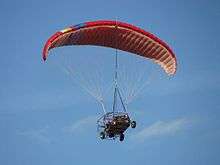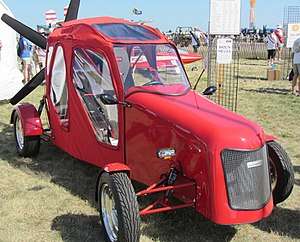I-TEC Maverick
The I-TEC Maverick is a powered parachute aircraft with a roadable fuselage.

| I-TEC Maverick | |
|---|---|
 | |
| Role | Powered parachute, roadable aircraft |
| National origin | United States |
| Manufacturer | Indigenous People's Technology and Education Center |
| Unit cost |
$94,000 in 2012 |
Design and development
Equipped with the largest powered parachute certified by the FAA, the Maverick received experimental aircraft airworthiness certification on April 14, 2008, with N-Number 356MV.[1]
Capable of interstate speeds on pavement, the Maverick's dune buggy-like frame of chromoly tubing gives it the ability to be used off-road. Additionally, the vehicle can deploy a parafoil and fly as a powered parachute. It weighs about 1100 pounds and has a useful carrying capacity equivalent to a Cessna 172 (fuel and 550 pounds cargo). With a 22-foot mast, the Maverick can take off and land in weather conditions that other powered parachutes would not be able to safely operate in. Steve Saint has said he envisions the Maverick being useful to the Huaorani and other Indian groups, farmers and ranchers, pipeline inspection crews and anyone else with a requirement to traverse rough, roadless ground. Popular Mechanics gave it their Breakthrough Award in 2009.[2] In 2012, the Maverick was accepted by the United States FAA to operate as an Experimental homebuilt, S-LSA, or E-LSA.[3]
Variants
- Maverick URVATV (Ultimate Roadable, All-Terrain, Aerial Vehicle)
- Initial model
- Maverick HPAV (High Performance Aerial Vehicle)
- Transaxle removed, fan drive only
- Maverick HPRATV (High-Performance, Roadable, All-Terrain Vehicle )
- Wheel drive only, convertible to flight.
- Maverick XTRV (Xtreme Roadable Vehicle)
- 300 hp (224 kW) wheel drive only.
Specifications (Maverick)
Data from Manufacturer
General characteristics
- Crew: 1
- Capacity: 1
- Powerplant: 1 × 2.5l Subaru Four cylinder, 190 hp (140 kW)
- Propellers: 5-bladed Warp Drive
Performance
- Cruise speed: 35 kn (40 mph, 64 km/h)
- Endurance: 3 hours
- Service ceiling: 10,000 ft (3,000 m)
- Rate of climb: 600 ft/min (3.0 m/s)
References
| Wikimedia Commons has media related to I-TEC Maverick. |
- FAA N-number registry
- Bolduan, Kate (2010-10-27). "Missionary builds flying car, FAA certifies it". CNN. Retrieved 2010-10-30.
- "Maverick Specifications". Retrieved 10 August 2012.